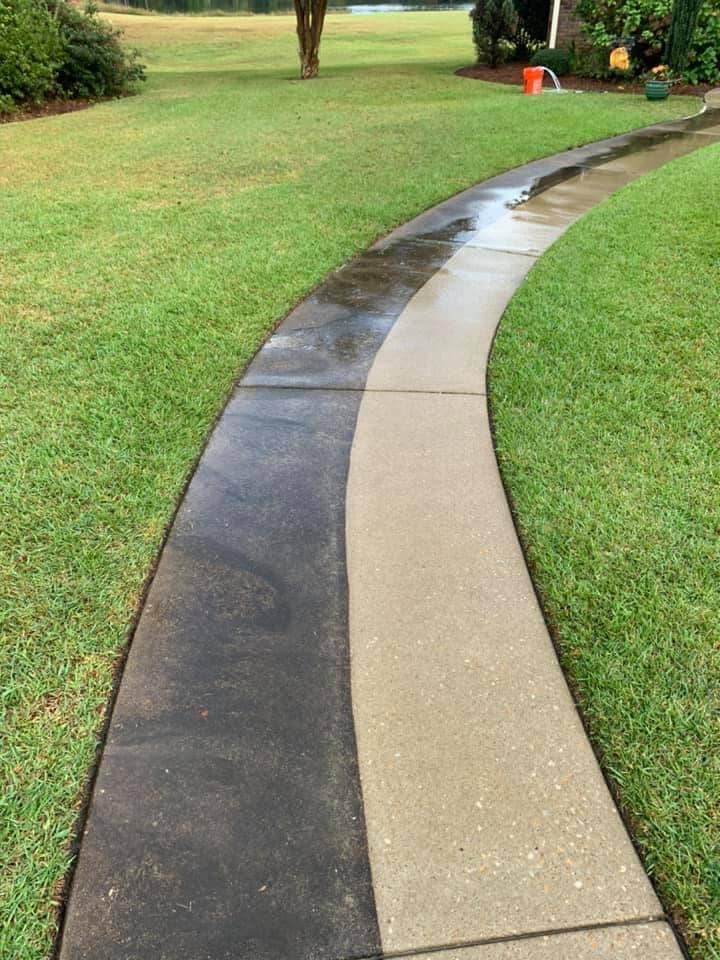Concrete surfaces, from driveways and sidewalks to patios and garage floors, are everywhere. Over time, they accumulate dirt, grime, stains, and sometimes even mold, making cleaning and maintaining them necessary. One popular method for cleaning concrete is pressure washing. However, a common concern among homeowners and property managers is whether pressure washing can potentially harm their concrete surfaces. In this article, we will dive deep into the world of pressure washing to determine whether it can cause damage to concrete and, if so, how to avoid it.
Understanding Pressure Washing
Pressure washing is a powerful cleaning technique that employs a high-pressure stream of water to remove dirt, grime, and stains from various surfaces. The key to its effectiveness lies in the force of the water, which can be adjusted based on the surface being cleaned. Pressure washers come equipped with different nozzles and settings to suit different cleaning needs, making them versatile tools for outdoor cleaning tasks.
The Benefits of Pressure Washing Concrete
Before delving into the potential risks, let’s first understand why pressure washing is a popular choice for cleaning concrete surfaces:
Effective Cleaning: Pressure washing can remove stubborn dirt, grime, mold, mildew, and stains from concrete surfaces quickly and effectively. It can make old and dingy concrete look new again.
Enhanced Curb Appeal: Clean, well-maintained concrete surfaces can significantly improve the curb appeal of your property. Whether it’s a driveway, patio, or walkway, a fresh and clean appearance can leave a positive impression.
Longevity: Regular pressure washing helps prevent the buildup of dirt, mold, and other contaminants that can cause long-term damage to concrete surfaces. This can extend the lifespan of your concrete and reduce the need for costly repairs or replacements.
Safety: Algae, moss, and mold can make concrete surfaces slippery and hazardous, especially when wet. Pressure washing removes these substances, making the area safer for walking and driving.
Preparation for Sealing or Painting: Pressure washing is essential if you plan to seal or paint your concrete surfaces. It ensures a clean, smooth surface that allows for better adhesion of sealants or paint.
Time Efficiency: Pressure washing is quick, making it ideal for larger concrete surfaces like driveways or parking lots. It can save you a significant amount of time compared to manual scrubbing.
Health Benefits: Removing mold, mildew, and algae from concrete surfaces can improve air quality around your property, benefiting people with allergies or respiratory issues.
The Potential Risks of Pressure Washing Concrete
While pressure washing offers numerous benefits, it’s essential to be aware of potential risks associated with this cleaning method:
Excessive Pressure: Using excessive pressure can damage concrete surfaces. High-pressure settings can lead to surface erosion and even cracks, particularly on older or weakened concrete.
Surface Damage: Pressure washing can sometimes result in surface damage, such as etching or pitting. This is more likely to happen if the wrong nozzle type or pressure setting is used.
Injury or Property Damage: Pressure washers are powerful tools that can cause harm if mishandled. There’s a risk of slips and falls on wet surfaces, and the high-pressure spray can damage nearby objects or landscaping.
Factors That Determine Concrete Damage
Whether pressure washing will harm your concrete depends on several factors:
Age and Condition of the Concrete: Older or more deteriorated concrete is more vulnerable to damage from pressure washing. Newer, well-maintained concrete is generally more resistant.
Nozzle Type and Pressure Setting: The nozzle type and pressure setting you choose are crucial in preventing damage. Using a wide-angle nozzle and starting with a lower-pressure setting is safer for most concrete surfaces.
Technique: Proper technique is vital. Holding the nozzle too close to the surface or staying in one spot for too long can cause damage. Maintain a safe distance and keep the nozzle moving.
Freeze-Thaw Cycles: Freeze-thaw cycles can be particularly damaging in regions with cold winters. Water can penetrate small cracks in the concrete, freeze, expand, and then thaw, causing the cracks to widen and leading to surface spalling and structural damage.
Chemical Exposure: Exposure to harsh chemicals, such as de-icing salts, acids, or industrial pollutants, can erode the surface of concrete and weaken its structural integrity.
Poor Construction or Workmanship: Inadequate construction practices or poor workmanship during the initial pouring and curing of concrete can result in various issues, such as inadequate compaction, improper curing, and weak joints.
Tree Roots: Tree roots can grow beneath concrete surfaces and exert pressure, causing cracks and heaving. This is especially common on sidewalks and driveways near trees.
Seismic Activity: In earthquake-prone areas, seismic activity can cause significant damage to concrete structures. Proper construction techniques and reinforcement are essential to withstand seismic forces.
Design and Quality: The design of a concrete structure and the quality of materials used play a crucial role in its durability. Proper mix design, concrete cover, and reinforcement are essential for long-lasting concrete.
Safe Pressure Washing Practices
To minimize the risk of damage to your concrete surfaces, follow these safe pressure-washing practices:
Choose the Right Pressure Setting: Start with a lower pressure setting and gradually increase it as needed. Test a small, inconspicuous area first to gauge the effect.
Use the Correct Nozzle: Opt for a wide-angle nozzle, such as a 25- to 40-degree spray pattern, for most concrete surfaces. This distributes the pressure more evenly.
Maintain a Safe Distance: Hold the nozzle at least 6 to 12 inches from the concrete surface. Avoid getting too close, as this can cause damage.
Keep the Nozzle Moving: Always move the nozzle in a sweeping motion. Never focus on one spot for too long, as this can lead to surface damage.
Signs of Concrete Damage
Knowing the signs of concrete damage is crucial. Look out for the following indicators:
Crumbling Edges: The edges of concrete structures, such as sidewalks and driveways, are susceptible to damage. Crumbling or eroding edges can occur due to foot or vehicle traffic, freeze-thaw cycles, or inadequate construction.
Cracks: Pressure washing can exacerbate or create new cracks, particularly in weak or older concrete. Concrete cracking can take various forms and sizes, including hairline, surface, and deep cracks. The presence of cracks is a clear indication of concrete damage. Cracks can be caused by various factors, such as freeze-thaw cycles, settling, structural stress, or chemical reactions.
Spalling: Spalling refers to the flaking, chipping, or peeling of the concrete surface. It often occurs due to freeze-thaw cycles, corrosion of embedded steel, or the use of de-icing salts. Spalling can lead to a rough and deteriorated surface.
Corrosion Stains: If you notice rust stains on the surface of concrete, it may be a sign of corrosion of embedded steel reinforcement. Corrosion can weaken the concrete structure.
Preventing Damage and Best Practices
Prevention is always better than a cure. Here are some preventive measures and best practices to protect your concrete surfaces:
Regular Cleaning: Regularly clean your concrete surfaces to remove dirt, debris, and contaminants that can cause staining or deterioration. Use a broom, leaf blower, or pressure washer (at a low-pressure setting) for routine cleaning.
Use Detergents and Cleaners: Concrete cleaning detergents can make cleaning more effective and less reliant on high pressure.
Avoid De-icing Salts: Avoid using de-icing salts like calcium chloride or sodium chloride on concrete surfaces in cold climates. These can accelerate concrete deterioration. Instead, use alternatives like sand or kitty litter for traction.
Proper Drainage: Ensure that your concrete surfaces have adequate drainage to prevent water from pooling or standing. Accurate grading and the installation of drains or gutters can help channel water away from the concrete.
Control Vegetation: Trim back or remove trees and plants with invasive roots near your concrete surfaces to prevent root growth and potential damage.
Protect Against Oil and Chemicals: Immediately clean up oil, grease, gasoline, and other chemical spills to prevent staining and chemical damage. Use an absorbent material like kitty litter to soak up spills before cleaning.
Regular Inspections: Periodically inspect your concrete surfaces for signs of damage, such as cracks or spalling. Address any issues promptly to prevent further deterioration.
Minimize Heavy Loads: Avoid placing heavy objects or vehicles on concrete surfaces not designed for heavy loads. Use load-bearing supports, or consider installing thicker concrete for driveways or parking areas.
Repair Cracks Promptly: If you notice cracks in your concrete, especially in areas exposed to freeze-thaw cycles, address them promptly by filling and sealing them to prevent water infiltration.
Alternative Cleaning Methods
If you’re concerned about the potential risks of pressure washing or have particularly delicate concrete surfaces, consider these alternative cleaning methods:
Scrubbing: Manual scrubbing with a stiff brush and a suitable cleaner can remove stains and grime without high-pressure water.
Soft Washing: Soft washing uses low-pressure water and specialized cleaning solutions to clean surfaces gently. It’s suitable for more delicate surfaces.
Chemical Cleaning: Certain stains and contaminants may require chemical treatments. Always follow the manufacturer’s guidelines and safety precautions when using chemicals.
In conclusion, pressure washing can effectively clean concrete surfaces, but it’s not without its potential risks. The key to preventing damage is to use the right equipment, techniques, and settings and be aware of your concrete’s condition. You can maintain your concrete surfaces without compromising their integrity by following safe pressure washing practices and considering alternative cleaning methods when necessary. Remember, a clean and well-maintained concrete surface not only enhances the aesthetics of your property but also prolongs its lifespan.

